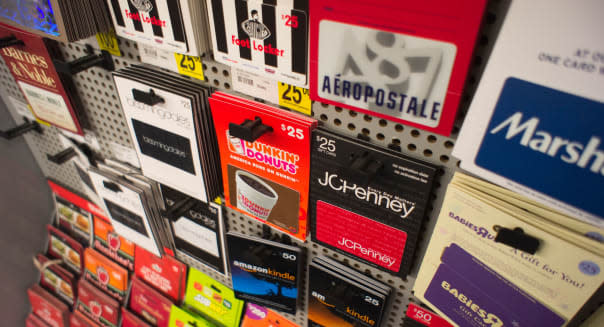Everything You Need to Know About Gift Cards This Holiday Season

They're "the gift most everyone buys for the holidays," according to USA Today. This holiday season alone, nearly 81 percent of shoppers will buy at least one gift card -- totaling nearly $30 billion, according to the National Retail Federation.
The benefits of buying gift cards are clear: They make great last-minute gifts (in a way that seems more personal than cash) and they vastly reduce the odds of you getting someone something just don't want or will never use. In fact, the percentage of consumers who made a holiday return has plummeted over the past few years as gift card purchases rose, according to data from America's Research Group.
But if you're not careful, these gift cards could end up leaving you -- or your giftee -- with less money than you thought.
Hidden Fees and Dates
Recent changes to federal law have made gift cards even more consumer-friendly.
%VIRTUAL-article-sponsoredlinks%For example, gift cards must now remain valid for five years. This law has worked as intended -- the amount unused on gift cards now only totals 1 percent of total sales ... down from 6.4 percent just four years ago, according to CEB TowerGroup.
But this unused amount still totals more than $1 billion each year.
To make sure your gift card purchase (or receipt) isn't included among these sunk costs, here are some tips to remember whether you're on the giving or receiving end of a gift card this year.
If You Are Purchasing a Gift Card:
1. Stick to buying store-branded gift cards. Bankrate.com's annual Gift Card Survey uncovered that the major gift cards offered through banks and credit card companies (generic Visa (V) or American Express (AXP), for example) charged either purchase fees or maintenance/inactivity fees (or both). On the other hand, only a small handful of store-branded cards reviewed carried similar fees.
2. Send either an e-gift card or purchase the gift card in store. Many gift cards (even store-branded ones) carry purchase fees disguised as "delivery fees." For example, Toys R Us sells gift cards on their website that come with a $1.95 delivery fee -- or $4.50 if you want it delivered inside a personalized greeting card. These fees amount to almost 20 percent and as much as 45 percent on a $10 gift card.
3. Look for promotions to save money. Many retailers offer gift card promotions this time of year. Like a free $10 bonus card currently offered when you purchase a $50 Applebee's gift card. Or a recent Groupon (GRPN) deal at Starbucks (SBUX), selling a $10 gift card for just $5. Also, don't forget to check out gift card resellers like CardCash.com and GiftCardGranny.com, where you can buy unwanted gift cards for up to 35 percent and 65 percent off, respectively.
If You Receive a Gift Card:
1. Spend the gift card as quickly as possible. Obviously, you should give your purchase some thought. But even though gift cards have a five-year shelf life, the longer you hold on to it, the more likely you are to forget about it or misplace it.
2. If you aren't spending it within a month, verify the gift card's terms. Visit the store's (or bank's) website to determine what fees are attached -- and when they kick in. If their website isn't clear, call the number on the back of the card to verify. Then add a reminder to your calendar to use the card well in advance of those dates.
3. If at all possible, register the card. Most companies will replace lost or stolen gift cards. But the only way this is possible is if you register the card in your name. Some companies will charge a replacement fee for the inconvenience -- but even this is better than missing out on the balance entirely.
4. Spend the entire amount so you're not left with pennies. You might be likely to discard a card with a small amount on it, so try to use it up in full. If you have a bank or credit card gift card, one blogger at BrightBacon.com has a creative solution: Buy an Amazon.com gift card for the exact amount of the remaining balance and immediately apply it to your Amazon.com (AMZN) account. This way, you'll be able to apply this odd amount to the next purchase you make at the leading online e-tailer.
Motley Fool contributorAdam Wiedermanhas no position in any stocks mentioned. The Motley Fool recommends Amazon.com, American Express, Starbucks, and Visa. The Motley Fool owns shares of Amazon.com, Starbucks, and Visa. Try any of our newsletter servicesfree for 30 days.

